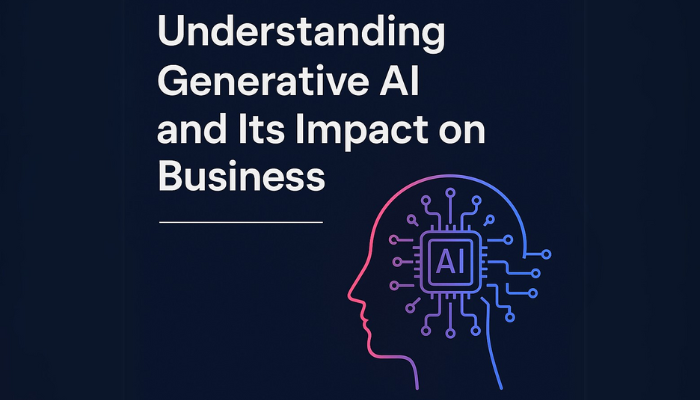In the past few years, artificial intelligence has made its way from experimental labs to boardrooms, but generative AI is the next frontier. It’s no longer about simply automating tasks or analyzing data, it’s creating entirely new avenues for growth and decision-making.
As a business leader, you’re always seeking ways to differentiate your company, improve operations, and stay ahead of the curve. But with generative AI, the question isn’t just about being faster or more efficient. It’s about leveraging a technology that enables your business to innovate at a pace and scale that was previously unimaginable.
For example, the shift in marketing strategies. Generative AI is being used by top brands to craft highly personalized campaigns in real-time, creating content that resonates with customers before they even realize they need it. This is not just the future, it’s happening now, and it’s reshaping industries from marketing to product development to customer service.
In this blog, we’ll cut through the hype and get into the practical impact of generative AI on your business. We’ll explore not just the technology, but how you can take real-world action to integrate it into your strategies, so you’re not just keeping up with change, you’re driving it.
Understanding Generative AI: The Basics
Generative AI refers to a class of AI systems that can generate new content, ideas, or solutions based on data they’ve been trained on. Rather than simply analyzing or categorizing existing information, generative AI creates entirely new things, from text and images to music and even code.
The market for generative AI is projected to reach US$66.89bn by 2025. With an annual growth rate of 36.99% expected from 2025 to 2031, the market size could increase to US$442.07bn by 2031. In global terms, the United States is expected to have the largest market share, with a projected size of US$21.65bn in 2025.
At its core, generative AI uses machine learning models to learn patterns in large datasets. Once trained, these models can produce new data that follows those same patterns, but is original and unique. Imagine teaching a system the nuances of a particular writing style, product category, or business model, then having it generate tailored, original outputs.
Here’s how it works in simple terms:
- Training: The AI learns from extensive datasets that include examples of the type of content or solution you want it to generate. For example, if you need it to write emails, you’d train it using a broad collection of existing emails.
- Generation: After training, the AI can create new content or ideas based on what it has learned. It uses patterns and insights from the training data to generate fresh output that matches the style, tone, or structure it’s been trained to mimic.
- Iteration: Generative AI continues to learn and refine its outputs over time. The more data it receives, the more accurate and tailored its creations become, providing you with solutions that are constantly improving.
For detailed information: What is Generative AI and How Does it Work in Development?
How Generative AI Stands Apart from Other Types of AI
Now that we’ve covered the basics of generative AI, let’s explore how it differs from other forms of artificial intelligence. While all AI models are designed to mimic human decision-making, their methods and roles can differ greatly.
1. Traditional AI vs. Generative AI
Traditional AI is often used for tasks like classification, recognition, or prediction. These systems are designed to identify patterns and make decisions based on data they’ve been trained on. For example, a traditional AI model might be trained to recognize fraudulent transactions by analyzing past transaction data. It won’t create anything new, it simply labels or categorizes information based on what it has seen before.
Generative AI, on the other hand, doesn’t just categorize or analyze, it creates. Instead of merely identifying existing patterns, generative AI produces new outputs that resemble the data it has been trained on, but are completely original. This can include anything from generating marketing copy to creating entirely new product designs.
2. Limited Learning vs. Continuous Learning
Traditional AI models are typically static once they are trained, they don’t adapt or evolve unless re-trained with new data. Generative AI models can be retrained or fine-tuned with new data, allowing businesses to refine outputs over time. As it is exposed to more data, it becomes increasingly adept at producing high-quality, relevant output. It can improve its accuracy and creativity over time without needing complete retraining.
Now that we’ve covered the basics and how generative AI differs from other AI forms, let’s explore the real-world benefits it brings to your business.
Benefits of Generative AI for Businesses
As a leader, you’re constantly looking for ways to optimize operations, enhance customer experiences, and innovate within your industry. Generative AI offers unique advantages that can help you achieve these goals, and more.
Increased Efficiency
One of the most immediate benefits of generative AI is its ability to handle time-consuming tasks. For instance, AI-driven content creation can automatically generate blog posts, social media updates, or email campaigns, saving your marketing team hours of work. This allows your team to focus on strategy and creativity, rather than repetitive content creation.
Cost Reduction
By automating processes like content generation, customer service, and even data analysis, generative AI helps reduce labor costs and increases overall efficiency. Additionally, AI-generated designs, prototypes, and marketing materials can eliminate the need for multiple revisions or third-party contractors, ultimately saving on production costs.
Innovation and Competitive Advantage
Generative AI can drive innovation by helping businesses explore new solutions and products. For example, AI can generate ideas for new services, design options, or even product features that your team might not have considered. This not only fosters innovation but also positions your company to stay ahead of the competition by quickly adapting to emerging trends.
Improved Decision-Making
Generative AI can process vast amounts of data, identify trends, and even predict future outcomes. This makes it a powerful tool for decision-making. Whether you’re determining which products to launch, how to allocate resources, or which customer segment to target, generative AI provides insights that help you make more informed, data-driven decisions.
Faster Time-to-Market
In industries where speed is critical, generative AI can accelerate development timelines. For example, in software development, generative AI tools can automatically write code, generate test cases, or even assist in debugging, allowing for faster iteration and quicker product launches.
Finding it hard to scale your content creation or automate repetitive tasks effectively? We help businesses use Generative AI to produce personalized content, automate workflows, and improve efficiency.
Applications of Generative AI in Business
Having explored the core benefits of generative AI, let’s now look at how this powerful technology is being applied in the business world today. Whether you’re in e-commerce, marketing, customer service, or product development, generative AI is making its mark across various industries.
Here’s how businesses like yours can implement it:
Content Creation and Marketing
Generative AI is transforming how businesses approach content creation. Tools like GPT-3 and Jasper AI can write blogs, generate social media posts, create email copy, and even craft product descriptions, all tailored to specific audiences. With the ability to produce high-quality content quickly and consistently, businesses can enhance their digital presence while freeing up creative teams to focus on more strategic tasks.
Customer Support and Chatbots
One of the most widely recognized uses of generative AI is in customer service automation. AI-driven chatbots and virtual assistants can engage with customers in real time, answering questions, processing orders, or resolving issues without human intervention. These systems can generate responses based on vast customer data, allowing for highly personalized and relevant interactions that improve customer satisfaction.
Product Design and Development
In industries like fashion, automotive, or technology, generative AI helps businesses accelerate product design by generating new prototypes and design options. By inputting a set of desired characteristics (e.g., size, weight, material), AI can generate multiple design alternatives that might not have been considered, speeding up the ideation process and improving product innovation.
Go from idea to AI prototype in 4 weeks, outpace competitors with a validated MVP.
Start with a free strategy session
Also Read: Using Generative AI in the Product Design Process: A Guide
Personalized Marketing Campaigns
Generative AI is making personalized marketing more powerful than ever. It can analyze customer behavior and preferences, then generate personalized messages, advertisements, and content that directly speak to individual customers’ needs. This hyper-personalization boosts engagement, conversion rates, and overall customer loyalty.
Predictive Analytics and Forecasting
Beyond content generation and design, generative AI is used for predictive analytics. By analyzing historical data, it can forecast market trends, customer behaviors, and even financial outcomes. These insights help businesses make smarter decisions about product launches, market entry, pricing strategies, and resource allocation.
Supply Chain Optimization
Generative AI can also play a significant role in optimizing supply chains. By predicting demand fluctuations, it can help businesses better manage inventory, reduce waste, and improve logistics planning. AI-generated forecasts allow for more efficient operations, reducing costs and ensuring that products are available when and where they’re needed.
Also Read: Exploring Generative AI Use Cases in Healthcare System
Challenges and Risks of Generative AI
While generative AI offers a wealth of opportunities, it also comes with its own set of challenges and risks that businesses need to be aware of. As you explore this technology, it’s crucial to understand both its potential pitfalls and limitations to navigate its implementation effectively.
Quality Control and Accuracy
Generative AI produces outputs based on patterns it has learned from data. However, it isn’t perfect and may generate content or solutions that aren’t entirely accurate or suitable for your business needs. For example, AI-generated content might sound convincing but lack nuance or context, requiring manual review and editing. Without proper quality control, relying solely on AI could lead to errors that impact your brand’s reputation.
Data Privacy and Security Concerns
Generative AI systems require access to large datasets to train and generate useful outputs. If these datasets include sensitive customer information, there’s a risk of data breaches or misuse. It’s essential to ensure your AI tools comply with data protection regulations (such as GDPR) and that you have robust security measures in place to safeguard both your data and your customers’ privacy.
Bias and Ethical Issues
Like all AI systems, generative AI can inherit biases present in the training data. If the data reflects biased assumptions, whether related to gender, race, or other factors, the AI may produce outputs that reinforce those biases. This can have serious implications, especially when used in customer-facing applications. It’s important to regularly audit AI models to minimize biased or unethical results.
High Initial Investment
Implementing generative AI in your business requires both financial and resource investments. While many AI tools are available at various price points, customizing these tools to fit your specific needs can be costly. Additionally, you may need to invest in the right infrastructure, data management systems, and employee training. For smaller businesses, this can be a significant hurdle, especially in the initial stages of adoption.
Integration with Existing Systems
Integrating generative AI with your current processes and technology stack can be complex. Depending on the tools you choose, there may be compatibility issues or a need for custom development work. This integration effort can take time and resources, and it’s important to plan for a seamless transition to avoid disrupting your daily operations.
Over-reliance on AI
While generative AI can automate many processes, it’s crucial not to become overly reliant on it. AI can generate creative solutions, but it lacks the strategic foresight, human intuition, and emotional intelligence that leaders like you bring to the table. Balancing AI-generated insights with human decision-making is key to making the most of this technology without losing the personal touch that defines your business.
Don’t let the complexities of generative AI hold you back. Our experts use advanced tools like OpenAI and GPT-3 to tackle data security, integration, and ethical challenges—ensuring your AI strategy drives measurable growth.
[Start the Conversation – Let’s Plan Your AI Strategy]
Key Considerations for Adopting Generative AI
As you begin to explore how generative AI can benefit your business, there are a few critical factors you need to consider before fully integrating this technology. These considerations will help ensure that you not only avoid common pitfalls but also make the most out of AI’s potential to drive growth and efficiency.
Align AI with Business Objectives
Before you adopt generative AI, it’s essential to clearly define how it will support your overall business goals. Are you looking to automate customer support, improve content generation, or enhance decision-making? Ensure that the AI applications you choose are directly tied to your key objectives. This alignment will help you measure ROI and avoid using AI for the sake of novelty.
Data Availability and Quality
Generative AI models require large amounts of quality data to produce reliable results. For businesses like yours, this means ensuring you have clean, structured data that can be used to train AI models effectively. If your data is fragmented or outdated, it may affect the quality of the AI-generated outputs. Invest in improving data collection and management processes to get the most from AI.
Scalability and Flexibility
Generative AI tools can often be scaled up as your business grows, but you need to choose solutions that offer flexibility. Look for AI platforms that can adapt to changes in your business or industry. You don’t want to be locked into a system that’s too rigid to grow with your needs. Ensure that whatever solution you choose can evolve alongside your business.
Team Readiness and Training
Your team will play a crucial role in the successful adoption of generative AI. Before integrating AI into your processes, make sure your employees have the necessary training to use these tools effectively. This could mean upskilling your marketing team to use AI-powered content tools or training your customer service staff to work alongside AI-driven chatbots. Preparing your team for AI adoption is just as important as selecting the right technology.
Cost vs. Benefit Analysis
Generative AI can involve significant upfront costs, whether it’s the software, infrastructure, or training. As a business leader, it’s vital to conduct a thorough cost-benefit analysis before committing to an AI investment.
A simple ROI formula to consider is:
ROI=Net Profit from AI InvestmentCost of AI Investment×100\text{ROI} = \frac{\text{Net Profit from AI Investment}}{\text{Cost of AI Investment}} \times 100ROI=Cost of AI InvestmentNet Profit from AI Investment×100
Key metrics C-level executives typically track to evaluate AI investments include:
- Time-to-Value: How quickly the AI solution begins to provide tangible returns.
- Operational Efficiency Gains: Measuring improvements in productivity or cost savings.
- Customer Acquisition Cost (CAC): The reduction in costs to acquire new customers through AI-powered solutions.
By tracking these metrics, you can ensure that your AI investment delivers measurable value in the long run.
Focus on use cases that will deliver tangible returns to ensure the investment is worth it in the long run.
Ethical Considerations and Compliance
As AI generates outputs, it’s important to ensure that these results align with your company’s ethical standards and regulatory requirements. From privacy concerns to ensuring fairness and transparency in AI decisions, you need to stay ahead of any potential legal or ethical issues. Make sure that the AI you adopt complies with relevant data protection regulations and that any content or solutions it generates align with your business values.
Vendor Selection and Support
When selecting an AI vendor, ensure they offer ongoing support and customization. Generative AI tools are not one-size-fits-all; they often need to be tailored to suit your specific business needs. Choose a vendor that understands your industry and can provide the support necessary to help you get the most out of your investment.
You’ve seen the potential—now, how do you bring it to life without the risks? At Codewave, we understand the challenges you’re facing, and we’re here to help you navigate them seamlessly.
Get Full-Spectrum Support for Your Generative AI Journey
We know the potential of generative AI, but we also understand the challenges in adopting it. That’s why at Codewave, we offer a complete range of Gen AI services to guide you through every step of your AI journey:
- Generative AI Model Development: We create custom AI solutions that are designed to meet your specific business goals, helping you stand out in the market and drive revenue growth.
- GenAI Model Replication: Scale your AI models to work across different industries or markets, so you can reach more customers and maximize impact without reinventing the wheel.
- Generative AI Integration: We help integrate AI into your existing systems, making your processes more efficient and giving you a competitive edge in your industry.
- AI Model Fine-tuning: We fine-tune your AI models to ensure they perform at their best, delivering results that align perfectly with your unique business needs.
- Custom AI Chatbot Development: We build AI-powered chatbots that are customized to your business, improving customer interactions, support, and satisfaction by providing fast, accurate responses.
- Prompt Engineering: We guide your AI to generate responses that are relevant and context-aware, ensuring more meaningful interactions and better user experiences.
- AI Solution Upgrade and Maintenance: We provide ongoing updates and maintenance for your AI solutions, ensuring they remain reliable and evolve with your business.
- Data Management: We help organize and manage your business data, making it easy to use for AI model training and improving overall performance.
- Natural Language Processing: We use AI to analyze and extract valuable insights from text data, helping you make smarter, more informed decisions for your business.
- Computer Vision: We implement AI that understands and interprets visual data, helping you automate tasks and improve operational efficiency.
At Codewave, we make generative AI work for your business, from strategy to execution.
Schedule a 30-Minute Discovery Call
Codewave is a UX first design thinking & digital transformation services company, designing & engineering innovative mobile apps, cloud, & edge solutions.







